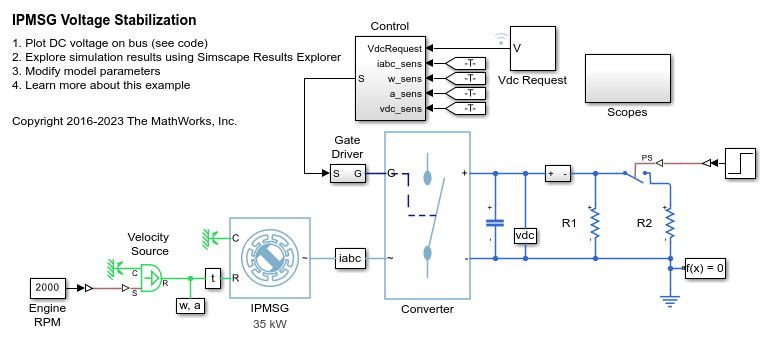Inverse Park Transform
dq0에서 abc로의 변환 구현
라이브러리:
Simscape /
Electrical /
Control /
Mathematical Transforms
설명
Inverse Park Transform 블록은 회전자 기준 프레임에서의 시간 영역 직접 성분, 직교 성분, 제로-시퀀스 성분을 abc 기준 프레임에서의 3상 시스템의 성분으로 변환합니다. 이 블록은 Park 변환의 불변 버전을 구현하여 회전자 기준 프레임에서의 시스템의 전력으로 유효 전력과 무효 전력을 유지할 수 있습니다. 평형 시스템에서 제로-시퀀스 성분(즉, 영상분)은 0입니다.
3상 시스템의 a축을 시간 t = 0에서 회전자 기준 프레임의 d축 또는 q축에 정렬되도록 블록을 구성할 수 있습니다. 아래 그림은 abc 기준 프레임과 회전자 d-q 기준 프레임에서 고정자 권선의 자기적 축의 방향을 보여줍니다.
a축과 q축은 초기에 정렬됩니다.

a축과 d축은 초기에 정렬됩니다.

두 경우 모두 각도 θ = ωt입니다. 여기서 각각은 다음과 같습니다.
θ는 q축 정렬의 경우 a축과 q축 사이의 각도이거나 d축 정렬의 경우 a축과 d축 사이의 각도입니다.
ω는 d-q 기준 프레임의 회전 속도입니다.
t는 초기 정렬에서의 시간(단위: 초)입니다.
아래 그림은 등가인 평형 dq0와 abc의 개별 성분의 시간 응답을 보여줍니다.
a상 벡터를 q축에 정렬

a상 벡터를 d축에 정렬

정의 방정식
Inverse Park Transform 블록은 a상에서 q축으로의 정렬을 위한 변환을 다음과 같이 구현합니다.
여기서 각각은 다음과 같습니다.
d와 q는 회전자 기준 프레임에서의 2축 시스템의 성분입니다.
a, b, c는 abc 기준 프레임에서의 3상 시스템의 성분입니다.
0은 고정자 기준 프레임에서의 2축 시스템의 제로-시퀀스 성분입니다.
전력 불변 a상에서 q축으로의 정렬의 경우, 블록은 다음 방정식을 사용하여 변환을 구현합니다.
a상에서 d축으로의 정렬의 경우, 블록은 다음 방정식을 사용하여 변환을 구현합니다.
블록은 전력 불변 a상에서 d축으로의 정렬을 다음과 같이 구현합니다.
예제
포트
입력
출력
파라미터
참고 문헌
[1] Krause, P., O. Wasynczuk, S. D. Sudhoff, and S. Pekarek. Analysis of Electric Machinery and Drive Systems. Piscatawy, NJ: Wiley-IEEE Press, 2013.
확장 기능
버전 내역
R2017b에 개발됨















